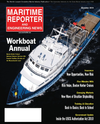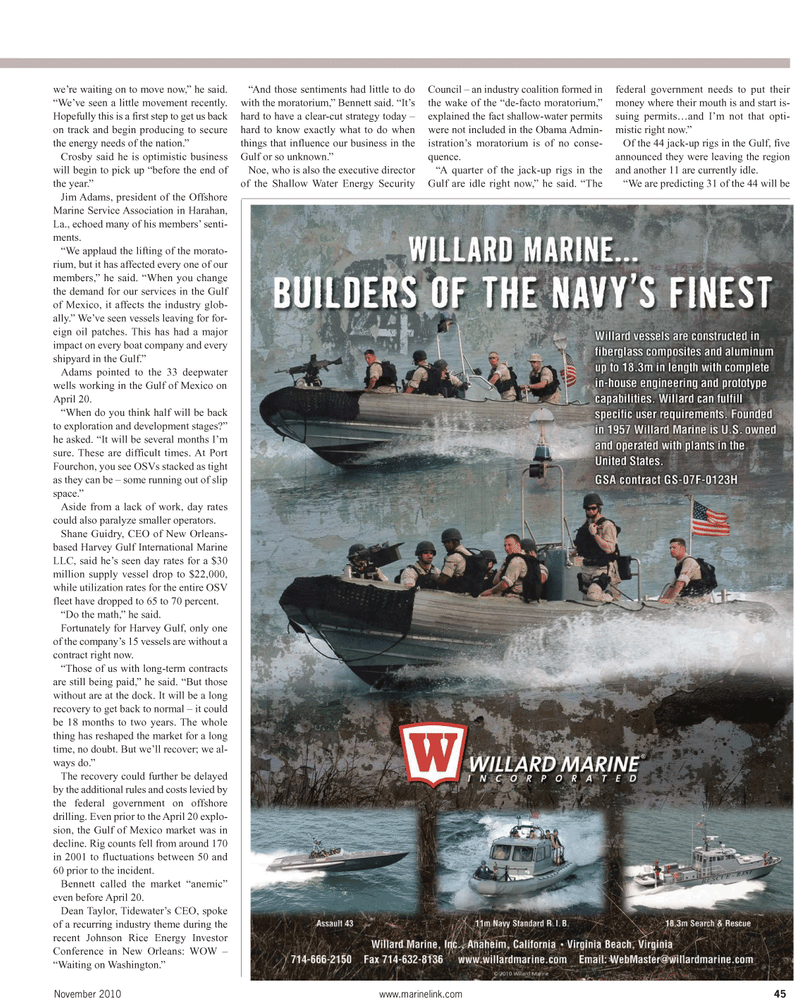
Page 45: of Maritime Reporter Magazine (November 2010)
Workboat Annual
Read this page in Pdf, Flash or Html5 edition of November 2010 Maritime Reporter Magazine
November 2010 www.marinelink.com 45 we’re waiting on to move now,” he said. “We’ve seen a little movement recently.
Hopefully this is a first step to get us back on track and begin producing to secure the energy needs of the nation.”
Crosby said he is optimistic business will begin to pick up “before the end of the year.”
Jim Adams, president of the Offshore
Marine Service Association in Harahan,
La., echoed many of his members’ senti- ments. “We applaud the lifting of the morato- rium, but it has affected every one of our members,” he said. “When you change the demand for our services in the Gulf of Mexico, it affects the industry glob- ally.” We’ve seen vessels leaving for for- eign oil patches. This has had a major impact on every boat company and every shipyard in the Gulf.”
Adams pointed to the 33 deepwater wells working in the Gulf of Mexico on
April 20. “When do you think half will be back to exploration and development stages?” he asked. “It will be several months I’m sure. These are difficult times. At Port
Fourchon, you see OSVs stacked as tight as they can be – some running out of slip space.”
Aside from a lack of work, day rates could also paralyze smaller operators.
Shane Guidry, CEO of New Orleans- based Harvey Gulf International Marine
LLC, said he’s seen day rates for a $30 million supply vessel drop to $22,000, while utilization rates for the entire OSV fleet have dropped to 65 to 70 percent. “Do the math,” he said.
Fortunately for Harvey Gulf, only one of the company’s 15 vessels are without a contract right now. “Those of us with long-term contracts are still being paid,” he said. “But those without are at the dock. It will be a long recovery to get back to normal – it could be 18 months to two years. The whole thing has reshaped the market for a long time, no doubt. But we’ll recover; we al- ways do.”
The recovery could further be delayed by the additional rules and costs levied by the federal government on offshore drilling. Even prior to the April 20 explo- sion, the Gulf of Mexico market was in decline. Rig counts fell from around 170 in 2001 to fluctuations between 50 and 60 prior to the incident.
Bennett called the market “anemic” even before April 20.
Dean Taylor, Tidewater’s CEO, spoke of a recurring industry theme during the recent Johnson Rice Energy Investor
Conference in New Orleans: WOW – “Waiting on Washington.” “And those sentiments had little to do with the moratorium,” Bennett said. “It’s hard to have a clear-cut strategy today – hard to know exactly what to do when things that influence our business in the
Gulf or so unknown.”
Noe, who is also the executive director of the Shallow Water Energy Security
Council – an industry coalition formed in the wake of the “de-facto moratorium,” explained the fact shallow-water permits were not included in the Obama Admin- istration’s moratorium is of no conse- quence. “A quarter of the jack-up rigs in the
Gulf are idle right now,” he said. “The federal government needs to put their money where their mouth is and start is- suing permits…and I’m not that opti- mistic right now.”
Of the 44 jack-up rigs in the Gulf, five announced they were leaving the region and another 11 are currently idle. “We are predicting 31 of the 44 will be

 44
44

 46
46
